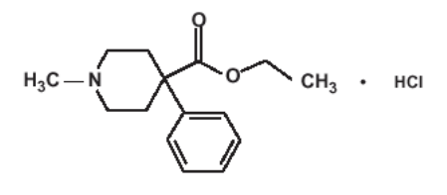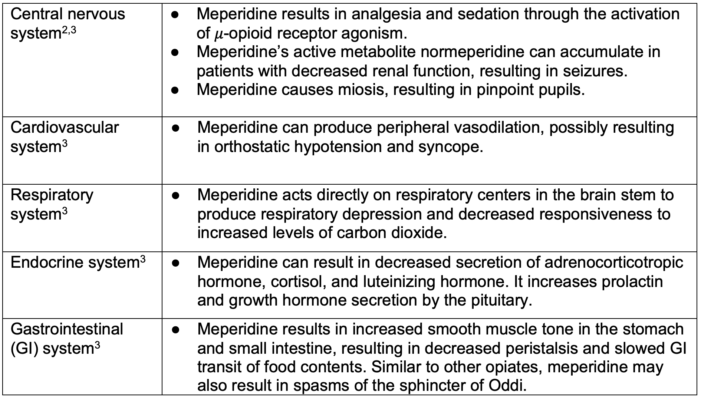Copy link
Meperidine
Last updated: 10/05/2023
Key Points
- Meperidine is a potent opioid analgesic that can be used for the treatment of acute postoperative pain and postoperative shivering.
- Meperidine should be avoided in patients with impaired renal function due to the risk of normeperidine accumulation, resulting in seizures.
- Meperidine is one of the more widely available parenteral analgesics for the treatment of acute pain in low- and middle-income countries.
Introduction
- Meperidine, also known as pethidine, is a potent synthetic opioid analgesic that can be used for the treatment of acute postoperative pain and postoperative shivering.1
- It is available as an injectable solution (for intravenous, intramuscular, and subcutaneous use), and in oral form (tablets and syrup).1
- The trade name for meperidine in the United States is Demerol.
Pharmacology
Physiochemical Characteristics
- Meperidine is a phenylpiperidine class hydrochloride salt. Its chemical name is 4-piperidine carboxylic acid, 1-methyl-4-phenyl, ethyl ester hydrochloride1 (Figure 1).

Figure 1. Meperidine chemical structure3
Mechanism of Action
- Meperidine functions as an analgesic as a result of central nervous system (CNS) μ-opioid receptor agonism, leading to inhibition of ascending pain pathways, altering pain perception, and resulting in CNS depression. Meperidine also has local anesthetic properties as the result of interaction with sodium channels.1,2
- Meperidine’s antishivering effects are thought to result from the activation of k-opioid receptors.1
Pharmacokinetics
- Meperidine has 65% first-pass uptake by the lungs with higher plasma protein binding than morphine.1
- Normeperidine is an active metabolite of meperidine with analgesic activity and a potency twice that of meperidine itself. Normeperidine has a longer elimination half-life than meperidine and can accumulate in patients with renal disease, potentially leading to seizures.2

Table 1. Dosage, metabolism, and elimination of meperidine
Systemic Effects
- The systemic effects of meperidine are listed in Table 2.

Table 2. Systemic effects of meperidine
Clinical Uses
- Meperidine can be used for postoperative pain management. It has demonstrated similar efficacy when used in patient-controlled analgesia (PCA) as morphine and tramadol in patients following total abdominal hysterectomy without significant differences in side effects. Patients receiving meperidine received an initial loading dose of 1 mg/kg at the end of surgery and then 0.2 mg/kg via PCA with a 10-minute lockout time.5
- Meperidine is effective for preventing and treating postoperative shivering.4
Adverse Effects
- Meperidine administration can result in life-threatening respiratory failure, and all patients receiving this medication should receive appropriate respiratory monitoring.1
- Meperidine is contraindicated in patients who have been exposed to monoamine oxidase inhibitors in the last 14 days due to the possibility of severe respiratory depression, cyanosis, hypotension, and coma as the result of unpredictable drug-drug interactions.1
- Administration of meperidine should be avoided in patients with decreased renal function as decreased renal clearance can result in the accumulation of the active metabolite normeperidine, leading to seizures.2
- Meperidine is an opioid analgesic, and its use carries the potential risk of opioid addiction and abuse.1
Resource Variable Settings
- Meperidine is rarely used for the treatment of acute postoperative pain in high-income countries as the result of the wide availability of other opioid analgesics.
- International trade restrictions, financial barriers, and variability surrounding national policy with respect to medical opioid procurement around the world have resulted in limited access to opioid analgesics in many low- and middle-income countries.6
- Meperidine is often one of, if not the only, parenteral opioid analgesic available for the treatment of acute perioperative pain in resource-variable settings.
- Meperidine is commonly used for postoperative pain relief following cesarean section in low- and middle-income countries. In settings where intrathecal opiates are available for use, careful consideration should be made for the need for postcesarean meperidine administration, and patients who receive both intrathecal opiates and postoperative meperidine should be closely monitored for oversedation.
- Given meperidine’s potential for abuse, consideration should be given to careful storage and monitoring practices in resource variable settings.
References
- Yasaei R, Rosani A, Saadabadi A. Meperidine. In: StatPearls. Treasure Island (FL): StatPearls Publishing; 2023. Link
- Dudley M, Miller R, Turnbull J. Opioids. In: Gropper M, ed. Miller’s Anesthesia. Ninth Edition. Philadelphia, PA: Elsevier; 2020:680-741.
- Pfizer. Demerol Dosage and Administration (Meperidine Hydrochloride Injection). Published: September 2020. Accessed: October 5, 2023. Link
- Kranke P, Eberhart LH, Roewer N, et al. Single-dose parenteral pharmacological interventions for the prevention of postoperative shivering: a quantitative systematic review of randomized controlled trials. Anesth Analg. 2004;99(3):718-27. PubMed
- Unlugenc H, Vardar MA, Tetiker S. A comparative study of the analgesic effect of patient-controlled morphine, pethidine, and tramadol for postoperative pain management after abdominal hysterectomy. Anesth Analg. 2008;106(1): 309-12. PubMed
- Morriss WW, Roques CJ. Pain management in low- and middle-income countries. BJA Educ. 2018;18(9):265-70. PubMed
Copyright Information

This work is licensed under a Creative Commons Attribution-NonCommercial-NoDerivatives 4.0 International License.